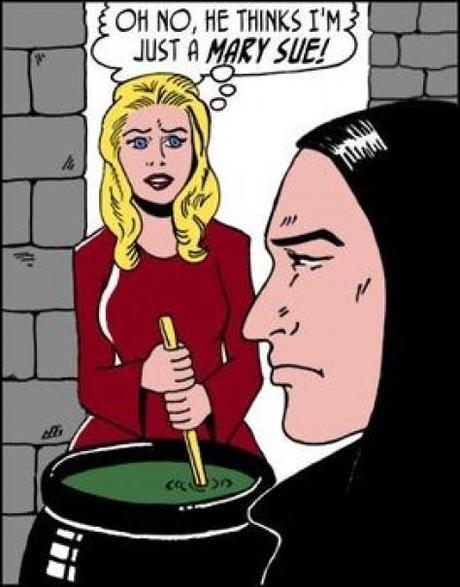 A Mary Sue is a stock character found in fan fiction that is an over-idealized version of the author. The stories she is featured in are usually poorly written and overly simplistic. The term is a derogatory one, as Mary Sues are universally denigrated in fan fiction.
A Mary Sue is a stock character found in fan fiction that is an over-idealized version of the author. The stories she is featured in are usually poorly written and overly simplistic. The term is a derogatory one, as Mary Sues are universally denigrated in fan fiction. In her book Enterprising Women, Camille Bacon-Smith explains that Mary Sue adheres to standard societal beauty standards by being “tall and slim, with clear skin and straight teeth;” is highly intelligent and educated, with “degrees from universities throughout the known universe;” and is resourceful, able to “save the lives of the crew through wit." Joan Marie Verba in Boldly Writing boils down the Mary Sue character to five points: she is young, adored by everyone around her, has abilities beyond the norm, is awarded extraordinary honors, and dies a widely mourned tragic or heroic death.
TV Tropes elaborates that although Mary Sue is universally loved, she has little to no personality. Despite this lack, every other character goes out of his or her way to serve Mary Sue’s interests; main canon characters often fall in love with her, regardless of their pre-established relationships, sexualities, and personalities. Mary Sue is always the main character of the story. She usually has a dramatic back story, and is consequently either constantly cheery or depressed. She is set apart from other characters because of her inherent perfection, and often complains about how difficult it is to be so “awesome.”
The original Mary Sue character appeared in Paula Smith’s 1973 Star Trek fan fiction story “A Trekkie’s Tale” in the fanzine Menagerie 2. In the story, Mary Sue is a 15-year-old lieutenant who singlehandedly saves the Enterprise; is awarded a Nobel Peace Prize; wins the hearts of Captain Kirk, Mr. Spock, Dr. McCoy, and Mr. Scott; and dies a tragic death.
Smith says that she did not create the infallible female stock main character when she wrote Mary Sue, but was parodying an existing trope. She popularized and demonized Mary Sue, criticizing fan fictions with main characters she deemed too Mary Sue-like.
Although Smith only gave her a name in the 1970s, Mary Sue has been part of literature since people started writing. The eponymous character of Pamela, or Virtue Rewarded by Samuel Richardson is a Mary Sue-like character, even though the book is from 1741. Several characters from literature written throughout the 1800s and 1900s could fit into the Mary Sue archetype, including beloved figures like the March sisters from Little Women and Nancy Drew.
Henry Jenkins in Textual poachers explaining that women write Mary Sues into their stories to personalize the canon and to become part of the media they consume and obsess over on a regular basis. Others believe that Mary Sue allows women to build alter egos for themselves and connect with the characters in a more tangible way, and yet others feel that women feel compelled to write Mary Sues to fill the void of characters like them.
Smith feels that Mary Sue “represents the teenage girl suddenly finding power.” As evidence, she cites the fact that the Mary Sue stock character became popular in fan fiction written by women in the 1970s, during the peak of Second Wave Feminism.
Bacon-Smith also points that Mary Sue rose to infamy in the 1970s. These women who wrote the original Mary Sue fan fiction had grown up in an era when strict gender roles prevailed; consequently, many people dismissed their interest in science fiction as masculine, and accused them of being tomboys. Developing Mary Sue gave these “intelligent women struggling with their culturally anomalous identities” a chance to create a character who is “an active agent with the culturally approved traits of beauty, sacrifice, and self-effacement, which magic recipe wins her the love of the hero.” Although some of these women produced Mary Sue stories in order to emulate the character, other writers wrote about Mary Sue to resent and reject her and what she represents.
Typically, only authors who are women are accused of writing Mary Sues, and only female characters are decried as Mary Sues. Young adult author Zoe Marriott has even said that people use the term “Mary Sue” synonymously with “female character I don’t like.”
Accusing characters of being Mary Sues can be a form of gatekeeping from well-established authors. It’s the Queen Bee effect: authors who have made it to the top of the fan fiction world want to be the only successful ones in the field, so they discourage amateurs from attempting to write fan fiction.
The Mary Sue accusation is also used by fans to police women’s writing and denigrate aspiring women writers. There are even entire online communities dedicated to finding fan fiction with Mary Sues and ripping apart the plotline and character. Bacon-Smith reports that all of this gatekeeping and policing has been effective, as many women have avoided writing female characters out of fear that fans will call them Mary Sues. Although Mary Sue is mocked and dismissed for being infallible, Captain Kirk is adored despite his own possession of overly exaggerated positive attributes. This double standard leads Bacon-Smith to posit that the fan community’s dismissal of Mary Sue is “a self-imposed sexism – she can’t do that, she’s a girl."

